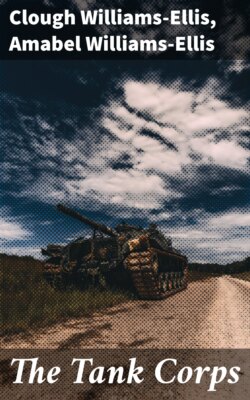Читать книгу The Tank Corps - Clough Williams-Ellis - Страница 24
На сайте Литреса книга снята с продажи.
III
ОглавлениеTable of Contents
About the end of December 1916, when the dual control of Tank affairs had been working for nearly three months, it became obvious that the system was not one that would easily stand the strain of active operations. The Tank Corps had outgrown it, and the shoe would soon begin to pinch. General Elles thus summarised the position in his report of December 31:
“In France. The fighting organisation is under a junior officer who faute de mieux has become responsible for initiating all important questions of policy, design, organisation and personnel through G.H.Q., France, and thence through five different branches at the War Office.
“In England. Administrative and training organisation are under a senior officer, located 130 miles from the War Office, with a junior Staff Officer (Staff-Captain) in London to deal with the five branches above mentioned.
“The system is working now because Headquarters in France have been free from the questions of operations for most of the last six weeks, and have, therefore, been in a position to deal imperfectly and at a distance with the larger aspects of the whole matter.
“This will not be possible when operations become a more pressing obligation, as they are now doing.
“Then, this duty must devolve either on the five War Office branches, not one of which, I submit with all respect, can have any comprehensive grip of the subject, or on the G.O.C., Administrative Centre, who is out of continued personal touch either with the War Office or the requirements in this country, and is, moreover, debarred by his charter from really having any control or direction except at the instance of his Junior.
“In actual fact, the Director-General of Mechanical Warfare Supply, an official of the Ministry of Munitions, at the head of a very energetic body, becomes the head of the whole organisation. This officer, owing to his lack of military knowledge, requires and desires guidance, which none of the five departments at the War Office can, and which the G.O.C., Administrative Centre, is not in a position to, give him.
“In effect the tail in France is trying to wag a very distant and headless dog in England. We have had one check already in the matter of the increased weight of Mark IV. which it is possible may have serious results as regards transportation.
“In view of the inevitable expansion and great possibilities of this arm of the Service, I wish to urge most strongly that a Directorate (however small to begin with) be formed at the War Office on the lines of the Directorate of Aeronautics. Its functions to be to study possibilities of development, to watch design and supply, to co-ordinate training and administer the Corps as a whole. The officer in charge to be a senior officer, free to travel and empowered to issue definite instructions and decisions as to requirements to the Ministry of Munitions.”
As a result of this remonstrance, General Capper was appointed to the War Office, and the first Tank Committee was set up in the following May.
This Committee was commissioned “to systematise and strengthen liaison between the Army and the Ministry of Munitions.”
But when we consider the list of its members we do not find a single representative of the still drooping “tail.”18
However, the appointment of the Committee proved to be a step in the right direction, and an improvement began to be felt immediately.
Officers of the Tank Corps now took charge of the final running trials of all Tanks. The M.W.S.D. submitted their designs to the Committee, and in several other small particulars the control exercised by the Military side was increased.
But in August the Committee was rent asunder.
A Memorandum was submitted by the two military members, calling attention to the long and serious delays that were still occurring in the preparation of new kinds of Tanks, after the execution of the designs had been approved by the Tank Committee.
The delays, it stated, were largely due to the absence of direct intercourse between the Committee as a body and the actual designer, and they recommended that the designer should be ex officio a member of the Committee.
Sir Albert Stern and Sir Eustace Tennyson d’Eyncourt dissented strongly from this Memorandum—we are not told upon what grounds—and in October a new Tank Committee was formed.
At last—upon this new Committee—the “tail” was fully represented, and the Committee met fortnightly alternately in France and in England, so keeping in touch with both factors in its work. A satisfactory organisation seems, in fact, to have been found, and the interests of all the departments involved in manufacturing and fighting these complex machines seem at last to have been adequately represented. After October difficulties appear to have been halved.
But this happier era did not dawn till after the Battle of Arras had been won, and the long misery of the Flemish campaign had somehow been endured. Meanwhile, as far as Tank control was concerned, things went on much as before.
The reader is to imagine that just such “growing pains” and just such difficulties, correspondences and memoranda filled in the background for the next six months, while the fighting at Arras, at Messines and in Flanders, whose story we are about to relate, was in progress.
